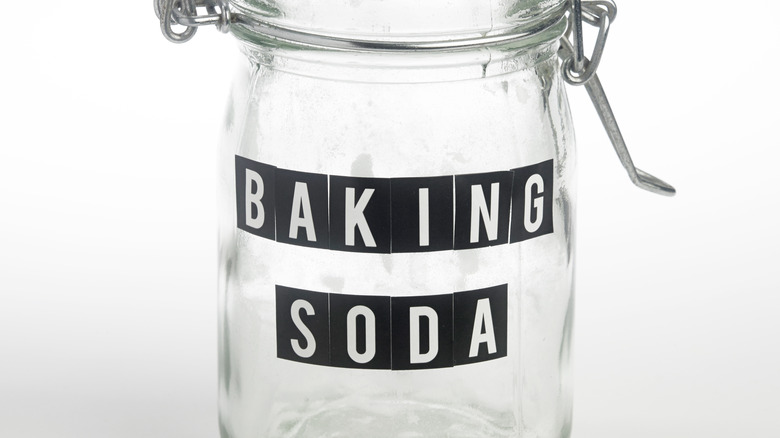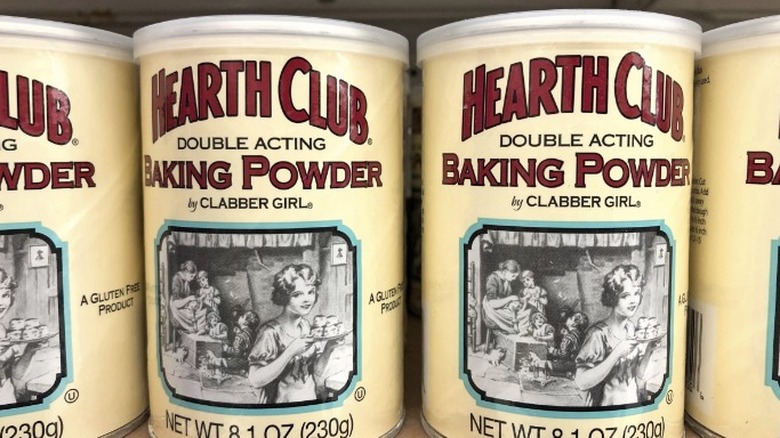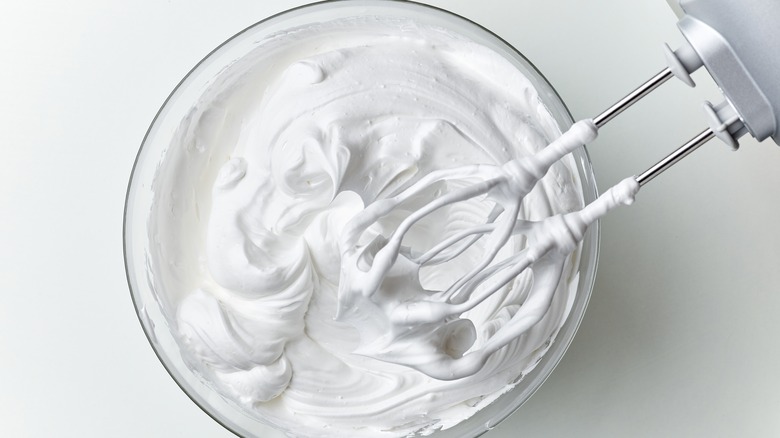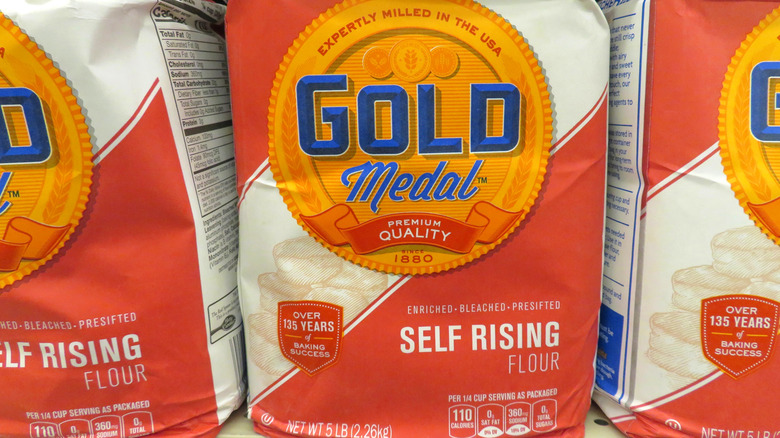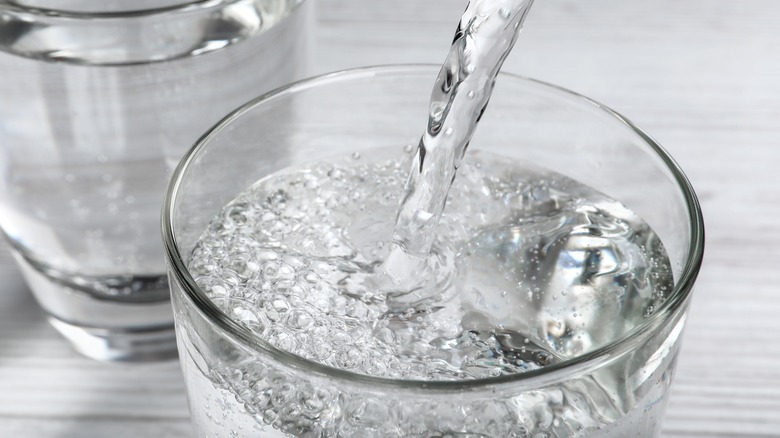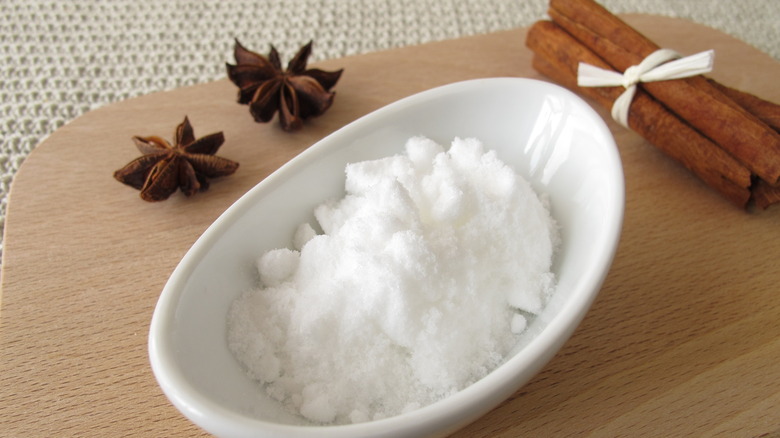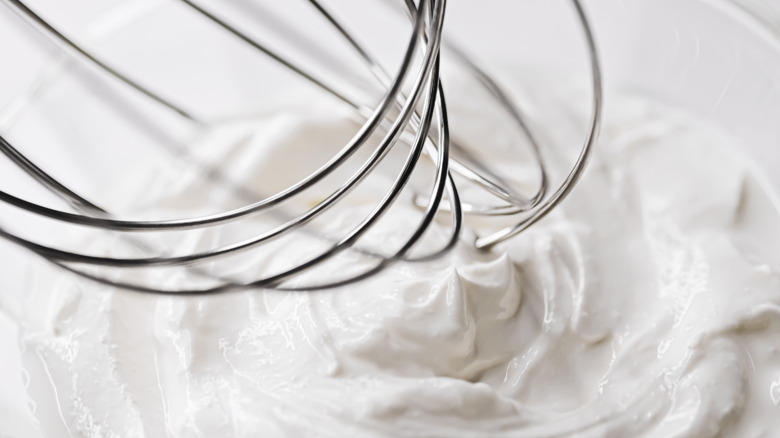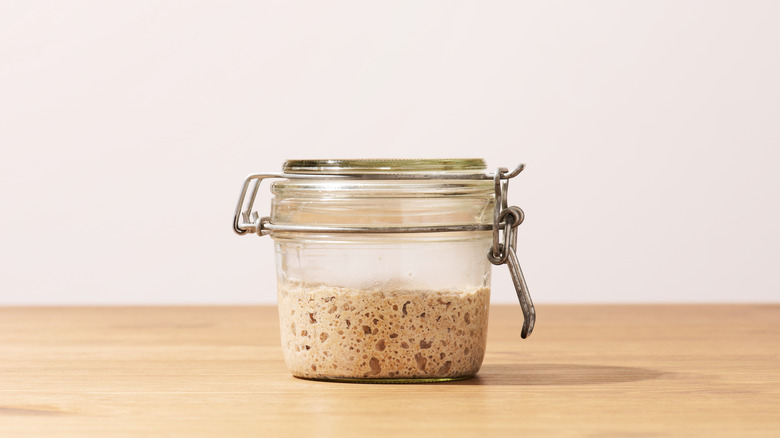Here's What You Can Use If You've Run Out Of Baking Soda
So, you've started a recipe only to find that you're missing one of the ingredients; we've all done it. Sometimes leaving out an ingredient works just fine and doesn't drastically alter the recipe's outcome. However, if it's baking soda that you've run dry on, it's something you should make up for with a replacement. Baking soda has crucial functions, so leaving it out of a recipe risks the food turning out entirely differently than it should. Baking soda is a leavening agent that chemically responds to acidic components.
With the existence of bubbling chemical compounds, the reaction is what creates soft baked goods such as scones or cookies because it makes them rise. It also affects the pH level (potential of hydrogen) of mixtures you use it in, which leads to preferable textures in foods. And, of course, it has other uses in the home as well, so it is a multipurpose product. Although baking soda is a kitchen essential, it is possible to do without it. Luckily, several substitutes work efficiently in a pinch. All of the alternatives listed here are solid stand-ins, so you can fruitfully carry on with your project, even with the absence of baking soda.
Utilize baking powder instead
If you have baking powder instead of baking soda, it indeed works as a substitute. Some might assume that these products are interchangeable and can be swapped for each other using exact proportions, but that isn't true because there are differences between baking soda and baking powder. As mentioned above, baking soda relies on acidic elements to do its job. Meanwhile, baking powder has cream of tartar, so the acid is built-in, so to say. Since they have different compositions, there is a specific way to swap baking soda and powder. In short, use three times more baking powder than baking soda.
So, if your recipe calls for 2 teaspoons of baking soda, use 6 teaspoons of baking powder. Here is the only downfall: This slightly alters the taste of your baked good and possibly makes it have a bitter undertone. This replacement works best in recipes where the baking powder flavor is overpowered by potent ingredients (think rich chocolate brownies or peanut butter cookies). This replacement is a good option for recipes that call for minuscule amounts of baking soda. Thus, if you're making a large batch of something, one of the other options on this list is likely better.
Fold whipped egg whites into your recipe
Did you know some baking recipes use beaten egg whites as the singular leavening agent? Soufflés and angel food cakes are just two examples of how foods can become cloud-like when you use this ingredient. Since whipped egg whites effectively help baked goods rise, it's more than achievable to use them in recipes that require a chemical leavening agent. The Incredible Egg reports the science behind how egg whites leaven foods: the air pockets forced into them broadens (up to eight times in size) during the baking process, which creates lift in the baked good. If your recipe requires eggs, using this trick is simple. All you need to do is separate the yolks and whites. Incorporate the yolks in, as usual, then whip the whites and cautiously fold them in.
However, if the formula doesn't call for any eggs from the get-go, there's still a way to use this hack. Today interviewed a food scientist, Renée Gan, who suggests you start with just two whipped egg whites as an alternative to baking soda. It's important to remember that you must compensate by removing some of the liquid in the recipe when you add the whites. Determine the volume of the unwhipped whites, then exclude the equivalent amount of fluid from the formula. After you fold in the fluffy whites, try not to be too rough with the batter, as you don't want to lose all the air you just mixed into it.
Use self-rising flour
One of the most straightforward solutions when you've run out of baking soda is to make use of self-rising flour rather than all-purpose flour. Self-rising flour became a southern pantry staple with brands like White Lily, known for its self-rising flour that yields ultra-tender pastries. You might wonder what the real differences are between bread, cake, self-rising, and all-purpose flour. Each flour has different protein content, which ultimately affects the texture and density of the baked goods. Self-rising flour stands out from the rest, though, because it has baking powder and salt evenly disbursed throughout it. This means that bakers who use self-rising flour can skip out on leavening agents altogether.
When you're stocked on all the necessary ingredients for everyday baking, this flour seems a bit unnecessary because it's more of a luxury. Nevertheless, its added elements are a saving grace in situations where you don't have another leavening agent on hand. Since its invention in the 19th century, it's proven to be a quality product that prevents baked goods from being unpleasantly heavy.
Replace some of the liquid with club soda
Here is a unique and quick fix you might be surprised about: club soda. There are a couple of reasons why club soda is a baking soda substitute that actually works. First, it commonly contains a small portion of baking powder; that property is what makes seltzer and club soda so different. Seltzer is just plain carbonated water that doesn't have additional minerals like club soda does. Aside from the add-ins, club soda also has plenty of air bubbles, which is just what you need when you don't have another raising agent.
Before you use this fill-in, be aware that adding it without adjusting the other fluid amounts in the recipe will completely change the consistency of the dough or batter. You don't want the mixture to be extremely runny. So, whichever amount of club soda you include, subtract that same portion of juice or other liquid to have a perfect balance (after all, baking is all about science, and having the right proportions are critical for the recipe to succeed). If the formula doesn't require fluids, it is best to use another option from this list.
Use baker's ammonia instead
Long ago, before baking soda and powder were kitchen staples, baker's ammonia was in the spotlight. Although it isn't as popular as it once was, this is a solid option to choose as a baking soda backup. Some recipes, like traditional German springerle, call for this ingredient as the sole leavening substance. Krinos reports that this product is quite beneficial when it comes to texture and density. Not only do bakes turn out quite airy when you use baker's ammonia, but their exterior is pleasantly crisp.
Baker's ammonia is known as ammonium carbonate and doesn't start to take effect until it's introduced to high-temperature environments. For that reason, you don't need to rush to get the batter in the oven when you use this product. With baker's ammonia, a noticeable odor occurs in the midst of the cooking process. However, don't sweat it; the smell slowly vanishes and doesn't linger, so the finished pastries have the same pleasant aroma as they would if you used other raising agents.
Fold whipped cream into your recipe
Like whipped egg whites, whipped cream is an effective makeshift that works for uncomplicated recipes. You mechanically incorporate air pockets into the heavy cream when you whisk it until it becomes pillowy. Rather than baking soda fizzing up and expanding the dough, the lightweight whipped cream lifts it instead. This fill-in is not necessarily the front-runner regarding the best substitutes for baking soda, but it carries out the mission if the goal is to make something straightforward like waffles.
Depending on what you bake, use your best judgment for the amount of whipped cream you add. Gently fold it into the finished batter or dough with a rubber spatula for best results. The batter should feel lighter but not watery, so start with the recommended amount and work your way up. One bonus of using this hack is that whipped cream is typically sweetened, so you can be at ease knowing it won't negatively modify the food's flavor.
Get creative with sourdough starter
Use sourdough starter as a unique way to create airy baked goods, both sweet and savory. It's important to note that this method slightly changes the overall taste of what you make, yet it is fantastic for people who enjoy the subtle taste of sourdough. Make sure you try this when you're not in a time crunch. With baking soda, you're able to pop goodies right in the oven, but with a starter, you need to allow time for the yeast to work.
Cultures For Health reports that you can tailor virtually any recipe to utilize sourdough starter, even quick bread; you just need to modify the formula's fluid and dry ingredient amounts. As a general rule, a starter contains a 1:1 ratio of flour and water. For example, if you add 4 ounces of starter, leave out 2 ounces of liquid and 2 ounces of flour from the batter. You can use this method for foods like pancakes, biscuits, and muffins, which is why you shouldn't throw out leftover sourdough starter.
